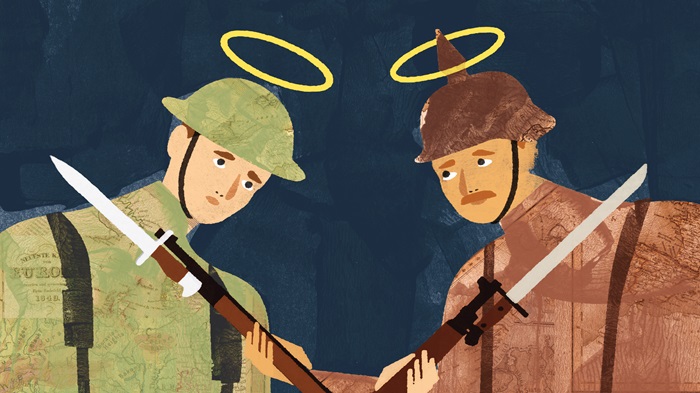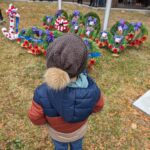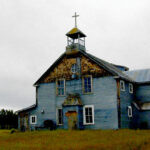Blog Post
A century on, the tragedy of the Great War that killed Western Christianity is still unfolding
By Jonathon Van Maren
As the Last Post played in cenotaphs and cemeteries around the world yesterday, millions marked the solemn anniversary: A full century since the guns of the Great War finally fell silent at 11 AM on November 11, 1918. Over seventeen million died in the muck in a war that would end empires, choke off dynasties, and devastate Western Christianity. Second Lieutenant C.S. Lewis described the Western Front as a place of “frights, cold, the smell of H.E. [high explosives], and horribly smashed men still moving like half-crushed beetles, the sitting or standing corpses, the landscape of sheer earth without a blade of grass, the boots worn day and night till they seemed to grow on your feet.”
Everyone who remembered the events is gone—the last World War I veteran, a British woman named Florence Green, died in 2012 at age 110. It is now up to us to remember, and efforts are made each year on Remembrance Day—although in the U.K., some idiots on the Cambridge Students’ Union voted against promoting the day of memory for fear it “glorified war,” indicating that they know virtually nothing about the First World War (or the mauling literature that came from the pens of those who survived it.) Because everyone who fought did so for things that seem foreign to us today—God and empire—we now project our own values on the fallen. There were more than a few appeals to “tolerance” and “diversity” at Remembrance Day ceremonies yesterday.
I remember my mother commenting years ago after attending the ceremonies at the Chilliwack cenotaph where hymns were sung, lustily by the older people and mumbled by the younger ones, that surely the government would not be able to pry religion out of these events—after all, the grave of each fallen soldier is still marked by a pure white cross (or, in the case of Jewish combatants, a Star of David.) And it is true that our memorials are testaments to the country we once were. “To the Glory of God,” reads the stone at the Brantford cenotaph near my house, which features an enormous grey edifice with the relief of a sword embedded in it, “And in the memory of the men and women of Brant Country whose names are here recorded who gave their lives on active service for Canada.” And then:
Rejoice ye dead, where ‘er your spirits dwell,
Rejoice that yet on earth your fame is bright,
And that your names remembered day and night,
Live on the lips of those who love you well.
In nearby Paris, the concrete memorial takes the shape of a cross, with names like Passchendaele, Vimy, Hill 70, and the Somme carved into it—and the solemn inscription: “To the Glory of God and the memory of the men and women of Paris who fell and in honour of those who served in the Great War.” The monument that towers among the trees directly facing Niagara Falls is topped by a soldier clutching his helmet and rifle, and is also dedicated to “the Glory of God” and the men of Niagara who “fell in the Great Wars,” the plural a nod to the savage conflict that followed the War to End All Wars.
It is perhaps ironic that memorials to our fallen war dead are so explicitly Christian, considering the sad fact that it was the Great War that gutted Western Christianity and killed the faith of millions. British writer Peter Hitchens writes of this beautifully in his memoir The Rage Against God, describing how the “spiritual mobilization” of the clergy on both sides of the war—pastors on the Allied side condemned Germany as united with the forces of Hell, while German soldiers wore belt buckles declaring “Gott mit uns” (God with us)—delivered a mortal blow to the credibility of the churches. They declared that the Great War was a moral crusade, and as faith in the cause died, faith in the spiritual leaders who backed it waned, too.
As a generation of Europe’s best and brightest expired miserably in the mud, much of the clergy extolled the virtues of nationalism. As it turned out, they had tragically hitched the forces of Christendom to the wrong horse. Many began to realize that this was the case as the horror continued to unfold, and began instead to preach of the Great War as God’s punishing hand on Europe—and there was certainly no way to debate that. But those who survived and returned as well as those who stayed began to develop a deep cynicism, and the scars of war were spiritual and psychological as well as physical. The bombs and bullets and gas had seared wounds inside the skulls of men as well as outside.
As we remember a generation of young men and women transformed into corpses by a pointless conflict, we should also remember that the tragedy of the Great War is still unfolding. We mourn not only the loss of those recorded in town squares and on memorials across Canada and almost every nation across the West, but also the silence that reigns in churches across Europe and the Commonwealth, uninterrupted except for the occasional click of a tourist’s camera. Many of these great cathedrals were built over generations by men who spent their whole lives building these houses of God, but now they are empty—memorials to the faith that once served as the lifeblood of Western civilization.








